UPDATE: The 2020 Marketing Technology Landscape is now available.
I’m delighted to release the 2017 edition of the marketing technology landscape, which we’ve nicknamed the Martech 5000, here at the MarTech conference in San Francisco.
As you’ve probably guessed from that moniker: the landscape grew again this year, by about 40%, to a total of 5,381 solutions (from 4,891 unique companies). You can download higher-resolution versions of this graphic, which you’ll need to zoom into in order to read it:
Marketing Technology Landscape Supergraphic (2017) — 4.6MB slide
Marketing Technology Landscape Supergraphic (2017) — 37.7MB hi-res JPEG
Marketing Technology Landscape Supergraphic (2017) — 61.2MB hi-res PDF
A few important notes, and then I’ll share more stats, analysis, and a final surprise at the end:
- This year, I was fortunate to have Anand Thaker collaborate with me on this project, from the research through to the origami-like folding of thousands of logos into a single slide. I’m incredibly grateful for his contributions.
- We expressly grant permission to reproduce copies of this graphic in any media, digital or physical, as long as it is reproduced “as is” and in full.
- This graphic is only our personal approximation of the marketing technology space and is surely rife with errors and omissions (our apologies). It is intended only to stir discussion.
- Key resources used in our research to build this graphic: CabinetM, Capterra, G2 Crowd, Google, LUMA Partners, Siftery, and TrustRadius. We used these services to discover new companies and to triangulate our categorization. As always, a debt of inspiration is owed to Terry Kawaja, the godfather of vendor LUMAscapes.
It is fascinating to observe the growth of this space over the past 7 years (feel free to look back at earlier martech landscapes from 2011, 2012, 2014, 2015, and 2016):
Statistics from the 2017 Marketing Technology Landscape
The official stats for this year:
- There are now 5,381 solutions on the graphic, 39% more than last year
- There are now 4,891 unique companies on the graphic, up 40% from last year
- Only 4.7% of the solutions from 2016 were removed (and another 3.5% changed in some fundamental way — their name, their focus, or their ownership)
That’s a non-trivial amount of churn, but still for this year, the rate by which new companies were added exceeds the rate by which others were removed.
Of course, not all of the new companies were launched in the year in which we added them to the landscape — many had been around earlier before we discovered them. (And we’re quite sure that there are many others that we missed this year too. Sorry.)
Another interesting statistic is the distribution of their size and funding:
- 6.9% are enterprises, with more than 1,000 employees or are public
- 44.2% are private businesses, less than 1,000 employees or no funding data
- 48.8% are investor-funded startups at any pre-exit stage
So for those who assumed most of these companies are tiny, it’s worth noting that over 300 are enterprises of significant scale. It’s also true that over 2,300 others have received some sort of investor funding — which implies scale beyond a couple of rouge developers in a garage (or, for a more modern-day cliché, two people in a coffee shop).
I’m actually most intrigued by the 2,000+ that are private companies that appear to be fully bootstrapped. I’ve written about the dynamics of modern software and marketing that make this feasible for a few years. But for a second opinion, I highly recommend reading The Rise of Non “VC compatible” SaaS Companies by Clement Vouillon, a research analyst at Point Nine Capital. The barriers to entry are extremely low.
Essentially, this market is a “long tail” distribution of martech vendors: a few $1+ billion giants, dozens of leaders with $100 million or more in revenue, and then THOUSANDS of smaller firms — from 1-3 person micro-SaaS companies to substantial firms with millions in revenue:
The Platformization of Marketing Technology
This long tail distribution above is interesting, because it reflects a pattern that we commonly see in open digital platforms: a few massive blockbusters and a vast stretch of niche offerings. Quintessential examples of this pattern are books on Amazon, music on Spotify, movies on Netflix, apps on Apple’s iOS app store, and so on.
The martech space has been a little different, however, since it wasn’t built up around a specific platform. In fact, most of the major providers downplayed this blossoming ecosystem because they wanted to position their offering as “everything you need you’ll get from us.”
But the spectacular scope explosion of marketing — and the rate at which new disruptions and innovations continue to roil marketing and business at large — has made it impossible for any one vendor to deliver everything that every marketer needs in a digital world.
Almost all of the major providers now acknowledge this, and they’ve shifted their strategies to embrace the ecosystem — becoming true “platforms” that make it easier for marketers to plug in a variety of more specialized and vertical solutions.
Most of these platforms/suites/clouds — based around CRM, marketing automation (MAP), and content management systems (CMS) — look a lot like classic platforms: they’re centralized repositories of data and services that other solutions plug into. Gartner’s vision of a “digital marketing hub” nicely captures this approach. Adobe, HubSpot, IBM, Marketo, Oracle, Salesforce, Sitecore, etc., are examples of leading centralized platforms.
But alternate approaches to platformizing martech have emerged as well. On the other end of the spectrum from centralized platforms, integration-platform-as-a-service (iPaaS) solutions let companies create “distributed” platforms — dynamically piping data between marketing applications and their own independent marketing data lakes.
While these distributed architectures are conceptually more complicated than a centralized platform, they offer a number of benefits, which I described in the section on microservices in my ebook 5 Disruptions Reshaping Marketing as We Know It — above all, tremendous flexibility to adapt to change. Vendors like Dell Boomi, Informatica, Jitterbit, Mulesoft, Segment, and Zapier are good examples of iPaaS and microservice platform enablers.
And yet another group of platforms sit between these two extremes, blending centralized and distributed philosophies: data management platforms (DMP), customer data platforms (CDPs), and real-time interaction management (RTIM) solutions. CDPs include firms like AgilOne, Lytics, RedPoint, Tealium, Treasure Data, and Usermind. Adobe, Oracle, and Salesforce all offer DMPs, but so do stand-alone vendors such as DataXu, MediaMath, Neustar, Rocketfuel, etc. RTIMs include Experian, Infor, Pegasystems, SAS, and Teradata.
The companies named above are just examples — see the landscape for a more thorough set.
The upshot of this platformization of marketing is that marketers are able to more easily build best-of-breed marketing stacks. Instead of choosing suite or best-of-breed, many marketers are now taking a suite and best-of-breed approach — using the suites as digital marketing hubs and then augmenting them with a range of more specialized products to bake their own, special marketing and customer experience cake.
Remember, marketing is about differentiation.
Instead of choosing suite or best-of-breed, many marketers are now taking a suite and best-of-breed approach.
Here are two great examples of such heterogeneous marketing stacks, from Microsoft and Cisco (click those links for larger illustrations and more detailed explanations of each):
For more examples, check out the other 57 marketing stacks from this year’s Stackies Awards.
I believe that this platformization will steadily reshape the “long tail” of the martech market. There will be increased consolidation when it comes to the core capabilities of coordinating customer data and campaign management. After all, there’s only so many general-purpose MAPs and CRMs the world needs. (Although disruptive challengers will continually arise.)
But ironically, consolidation at the platform level will facilitate greater diversity and innovation at the next level up, as more specialized and vertical market developers build on top of those foundations. As a result, I hypothesize that the martech landscape will remain quite large for some time — but it will increasingly have more structure in how it’s organized, both in the market and in marketers’ operations.
It’s going to continue to be a fascinating space for quite some time ahead.
Spreadsheet of the 2017 Marketing Technology Landscape
As Steve Jobs used to say, “One more thing…”
The number one request I’ve had for the marketing technology landscape — other than “please add my company” — has been, “Could you share a database of these vendors?”
So, thanks to Anand’s help this year, we’re pleased to make a Google sheet of all companies on the landscape, the solutions under which they’re categorized, and their website URLs — freely available to the community:
Feel free to cut-and-paste this data and use it as a starting point for your own research. We’d love to hear about what you discover.
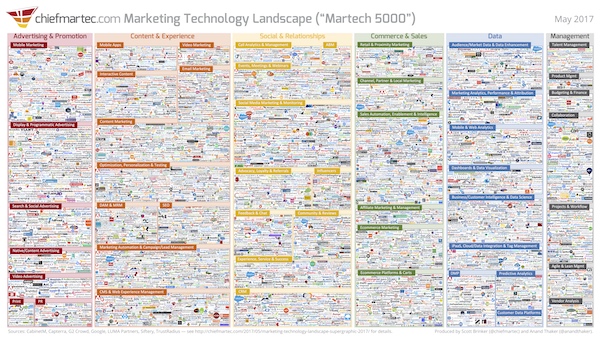
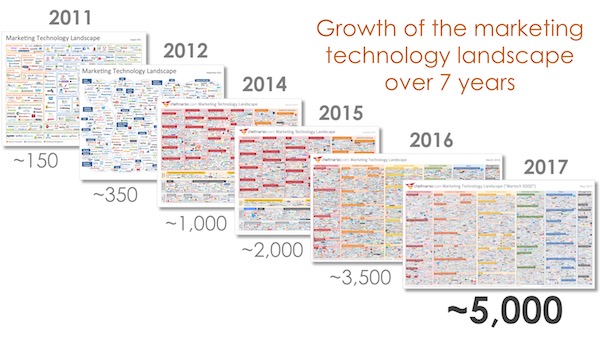


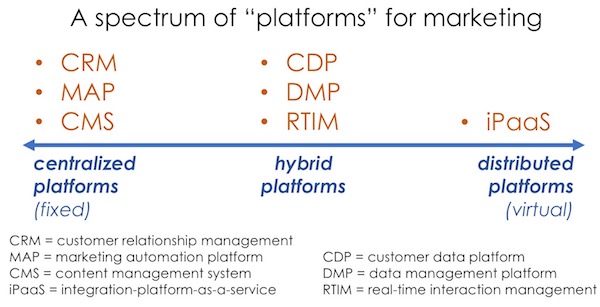
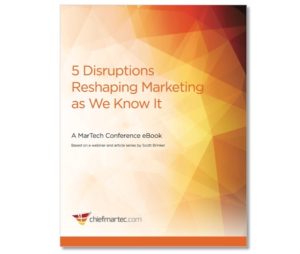


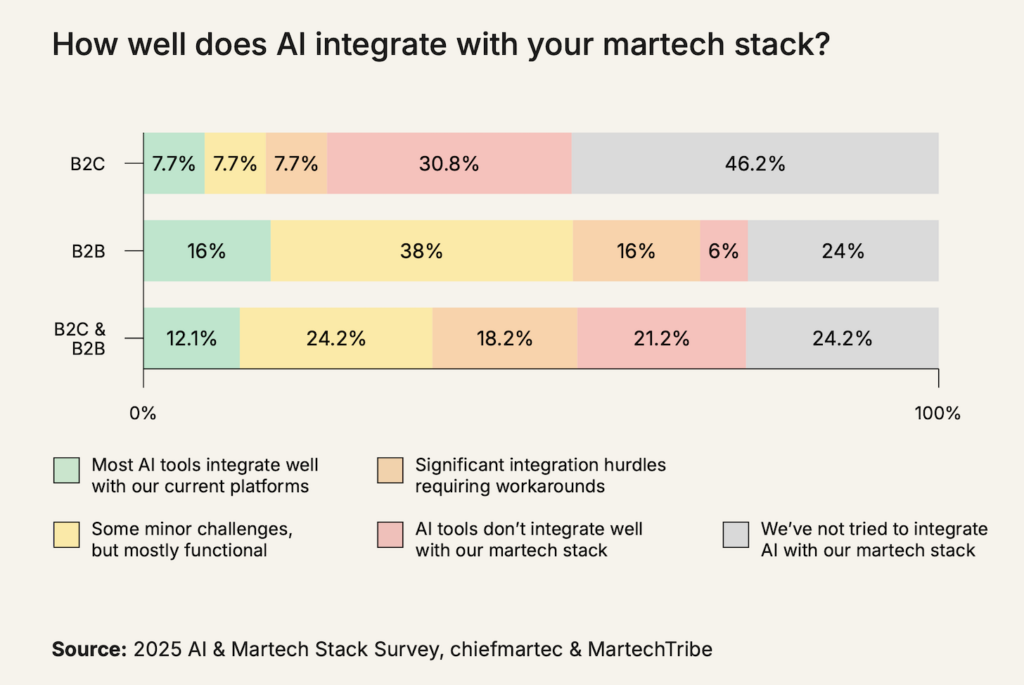
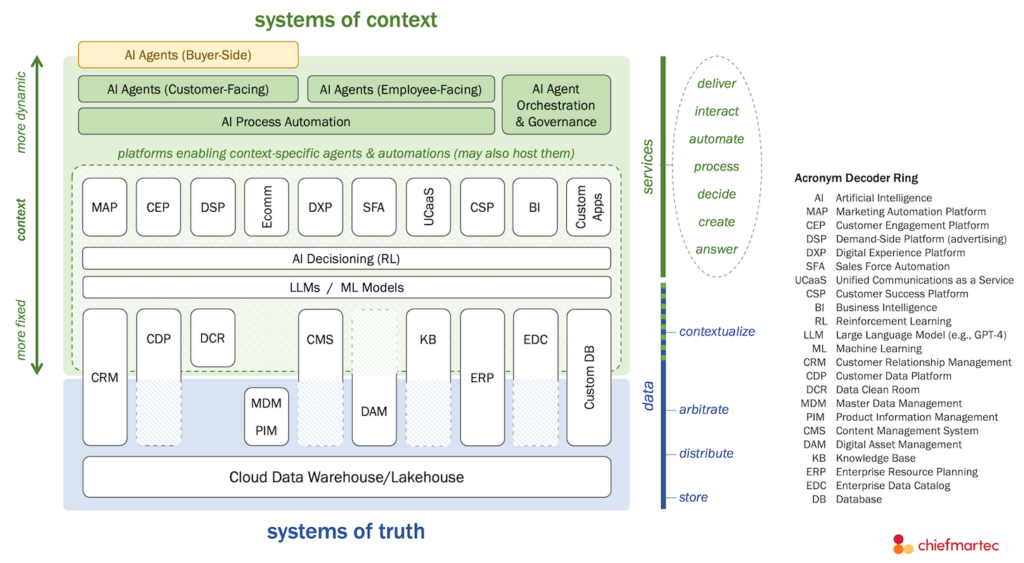
Amazing job. This is truly a monumental task.
PS typo in the post title, technology
Been looking forward to this for a while. Thank you so much Scott and Anand.
This has become a highlight of the year for me, and 2017 did not disappoint! Thanks for this amazing contribution to the Martech community, and the spreadsheet is a really nice bonus.
If there is a typo (Website) within how best to contact to have it fixed?
LeadiD (not Lead ID) and should be LeadiD.com (not .net). The firm rebranded the site LeadiD.com still work, it will redirect to their new brand name JORNAYA, Jornaya.com – same services (Predictive Analytics, Sales Enablement Data, B2C Consumer Journey Insights). You can delete these posts just wanted to provide you the accurate spelling and website. Thank you.
Proud that @mavsocial has been your amazing work since 2012! Great work again
Great work! Congrats
As always, kudos to Scott and now to Anand, too. Thank you
Thanks. The 3rd link is not a PDF.
Simply amazing! Thanks for this great article and your love and passion for marketing technology!
Great work! Just a quick note that the highres PDF link isn’t working (point to a JPG now). The correct link is http://cdn.chiefmartec.com/wp-content/uploads/2017/05/marketing_technology_landscape_2017.pdf.
@Scott: Thanks so much for including us (again) this year in the ABM category. I would like to know what it takes to get considered for additional categories in the future. Our platform crosses a couple of additional area. Thanks! And great job with this!
Very comprehensive! Surprised to not see Brandlive included for Content, Social or Commerce. Check it out for next year’s landscape http://www.yourbrandlive.com
I can’t see name of Streamlyn media.
They have a great grip in APAC market.
Yeah correct !! Streamlyn is a full stack programmatic advertising company with great team and effective revenue generating model for publishers by optimizing their audience
Clever click through on the Google sheet. Great work. And I thought 2011 was complex!
Thank Scott! Very useful as always! 🙂
Thanks so much also for sharing the Google Sheet of source data. It’s super helpful to be able to quickly search by name than “logo hunting”. Much appreciated!
Great work on the report. The whole sector has exploded as predictions. Also thanks for the reference to “The Rise of Non ‘VC compatible’ SaaS Companies by Clement Vouillon”; we are an “awesome Bootstrapped SaaS company” with a lean and profitable SaaS business.
Great list! Project management is missing Workzone which has been around for quite awhile (longer than a lot of those companies!) Maybe next year! https://www.workzone.com/blog/
Look closer, Josh. 🙂
Oh there it is! Workzone updated our logo…so we’ll have to get that over to you guys, thanks!
I jokingly said “Great, we need solutions to help select solutions.” Then, I noticed the Vendor Analysis section in the bottom right. We’ve come to that.
Great work. I can only imagine the level of effort here.
In the part of eCommerce there is an image of our company FANPLAYR but then is not in the list of the spreadsheet.
Another year where Datarista hasn’t made it. Next year we are going to be on the radar!
This is great work! Thanks for sharing. although some of the vendors seem out of place. I don’t think there’s anything about Host Analytics or Workday make them Martech?
Screen6 is missing. There is no bucket for it though…
Nice work! We are LeadsRx, a marketing attribution vendor who also happens to qualify for your “Bootstrapped SaaS Company” category. Let us know what we can provide to get on your wonderful chart for next time!
Thanks a lot for the report and your effort! It’s really helpful to have a spreadsheet to check out the whole list. However, I’m surprised that MOCA Platform is missing from this list for Mobile Marketing, Retail & Proximity Marketing or Mobile Analytics category. We are a SaaS Mobile Marketing platform focused on location targeting and behavioural data and last year we were honored at the prestigious GLOMO Awards as the Best Mobile Cloud Service.
Please, check it out for the next report https://mocaplatform.com/ Thanks and again..great job!
Great overview Scott, it is very helpful. Are you also planning to rate these technologies. I am focusing on Marketing Automation and prepared an overview based on user reviews: https://www.marketingautomationcomparison.org/best-marketing-automation-systems-reviews/
Could this be of interest for all 5000 Marketing Technologies?
Very useful work! Thank you. I expected to see segmentify.com in the list as well. Next time hopefully 🙂
Hi Scott, Congratulations. Great work on this herculean tasks. Appreciate the idea of adding the google sheet, it really helps. And thanks very much for featuring ‘Fiind’ (http://www.fiind.com ) under Predictive Analytics category. We hope to find ourselves in other categories where we are expanding. Congratulations again.
Can you tell me if Strategic America is on there? I don’t see it…
Where is Amazon in any of the categories? They seem to be a player in multiple areas with the broken out groupings these days.
Great list of market players. It will definitely help us to get a better overview and connect to all the companies more easily. Maybe ayetstudios.com will make it on the list next year as well.
Great list, really comprehensive. Could you please add aklamio.com next year to the Referral category?
Great list. I think you forgot to include https://mention-me.com/ in the Advocacy, Loyalty and Referrals section 😉 Maybe next year?
Hi! Who can I contact regarding the landscape? I would like to add my company to one of the categories
Scott and Anand, Thank you for putting this together. Could you please add Quaero (www.quaero.com) to your list of Customer Data Platforms? Thanks.
Thanks Scott – Vidiro Analytics should be included in the Video Advertising Section. We are a Dublin based company providing Content Driven Targeting for accurate and relevant Ad Placement on YouTube – everyone else is trying to do Contextual Placement, we already do. Check us out! 🙂
Hi Scott, You’re missing RockeROI https://www.crunchbase.com/organization/rocketroi#/entity
Great graphic. Is there a tool that will help you make that “supergraphic”? I’d like to create one for my own industry.
Hello Scott. Great work on this but you seem to be missing 3Cinteractive, https://www.3cinteractive.com/. Hope to see it on your list next year.
A vertical market CRM called Wild Apricot could be added under CRMs. The taget market for Wild Apricot is associations and clubs. Blackbaud is a similar competitor already in the CRM subcategory.
Obviously, a lot of time and energy to compile the list (and logos) 🙂 Good work! BUT wow… that is a big list. I’ll keep the page bookmarked. Thanks!
As for the other comments by people saying, “… you forgot one… “, thinking those people need to work on their marketing 😉
Hi Scott, thanks for the list – great resource!
The sheet seems to be missing RewardStream under Advocacy, Loyalty, Referrals: http://rewardstream.com/
Where is Oracle Service Cloud in the Experience, Service & Success section?
cg
Towards the middle upper left. The red ORACLE logo. It’s like Find Waldo. 🙂
Scott,
This has been helpful and I will be linking to this page in a forthcoming post. Btw, you are very gracious to those of us who don’t bother to use the Google sheet to lookup whether our company is listed there.
There’s a glaring hole in the “Community & Reviews” section. You’re missing ConsumerAffairs.com which was named the #1 reputation management tool in 2016 by Entrepreneur.
Had a nice conversation with Anand at the MarTech event in SF about Automat and the work we’re doing with Conversational Marketing (http://www.automat.ai/what-is-conversational-marketing.html). This new category of marketing is really coming into its own based on work we’re doing with L’Oreal, Covergirl, National Bank of Canada and others. We also just raised a Series A led by Brandtech group You & Mr Jones to accelerate our product and market development. Would be great to be included in the next iteration of the landscape.
This is immensely helpful and major kudos goes out to Scott and Anan.
Is anyone able to download the spreadsheet? I’m not familiar with google sheet and having a hard time transfering to excel. Thanks in advance for any help!
Great work, Scott. Innovation is seen in all categories.
Please consider Advo.Ninja, an innovative employee advocacy platform focusing on personalization and deep text.
Amazing job. thanks a lot and keep it up.
It would be nice if the spreadsheet data was on github so others could contribute.
One landscape that is always underreported is the mobile landscape.
I cull DNS logs on my phone to see what companies I can find and right now I can see a few that might be worth adding:
sense360 sense360.com Bluetooth beacon advertising stuff for apps.
Adzcore.com which takes me to Playtrack which takes me to a company called Adways.com
lkqd http://lkqd.squarespace.com/ video ads
smartclip http://www.smartclip.com/ video ads
http://cliipa.com/
I have about 350 DNS records I’ve blocked so far on my phone and these were just in the first 20 I’ve logged.
I just think the mobile space is very much underreported not only from a list such as this but also in ad blocking efforts. I know my motivation goes against what you all do but viewing DNS queries from a phone tells me how many new companies are cropping up due to mobile advertising and analytics and I can guarantee I could list dozens more without trying.
A github page would really be beneficial for culling lists. We could submit url’s, classification, domain name, logo, etc. for approval to submit.
I’d also suggest relevant additional domain names because, as you probably know, mergers and acquisitions, etc. lead to multiple sources ending up under 1 true company.
fyi, for another resource take a look at DNS blocklists
https://filterlists.com/ maintains a list of… lists of DNS hosts file lists and adblock filters to block network traffic to such companies.
We’re talking hundreds of thousands of known analytics and advertising companies (along with malware hosting sites and junk.) I don’t think one team could even come close to putting together an actual list of a current landscape.
Even with all of these lists I’d have to parse out the duplicates, verify active WHOIS domain registrations, and then investigate each record to see the parent company and what they actually do.
Anyways, I know it’s the opposite of what you all do but I figured it might reveal some other ways to find the same sorts of info.
Browser add-ons such as UBlock Origin https://en.wikipedia.org/wiki/UBlock_Origin is where these sorts of lists are used.
Scott, what an amazing overview! I am in a process of evaluating a few systems, and this info that you have put together is extremely helpful! Would you consider any updates to this list?
Our marketing management and collaboration platform CrossCap (www.crosscap.com) is not featured but could be a nice addition to your fantastic research! Thank you so much again for putting this together!
That’s very impressive!
Here’s the zoomable version:
https://www.zoomo.ca/image/iCId
In case anyone is looking for the direct link:
https://docs.google.com/spreadsheets/d/1sgmWCLerELolXlHHMFHdxTWvBLIfmNrKTrlbz0vBW4E/pubhtml/sheet?headers\x3dfalse&gid=0
Does anyone know if there is some sort of glossary that defines each of the sub-categories in the landscape?
Hi Scott,
It is only when you see the technology vendors on your visual chart each year that you get a true appreciation of the growth and size of this technology space. I can only imagine the time and research that goes into it each year – incredible!
I would love to see admation (www.admation.com) included on the 2018 SuperGraphic.
Admation falls in the marketing project management category. Admation is a private company that is fully bootstrapped, that provides project management and marketing approval workflow software to a range of global brands and ad agencies. Any details on how we could be added to your growing list would be truely appreciated.
Warm Regards,
Great job!!!
BTW: ROI Hunter is missing (roihunter.com)
Seems like several of the Gartner leaders and market share leaders were left out of Email Marketing Category. (Salesforce (ExactTarget), Oracle (Responsys) Am I missing something?
Many just expanded into marketing automation / campaign management as a better description of their offering. (Just one man’s opinion.)
I agree with Justin. We are using https://www.newsletter2go.com. They do only email marketing and they are not on the report either.
Always a fascinating topic. I love the piece about Microsoft’s ideal stack. One can have the best Martech in the world, but if it is not compatible or not relevant to your field – it will do little good. Usage, people, and vision all play a role in effective and profitable marketing technology. Many come and go, but any that are worthwhile either grow or get purchased.
Cubeyou is missing 🙂 please check us out (www.cubeyou.com) we fit on the Social Media Marketing & Monitoring section
BTW Incredible job to vet so many companies!!
Thanks for including us amongst such great company in your list of recommendations!
Hi – Lanyon is there twice.
Hi Scott, Unbelievable job pulling all this together!
Quick name change correction: iJento is now Fospha. We sit primarily in ‘Marketing Analytics, Performance & Attribution’, ‘Customer Data Platform’ and ‘Business/Customer Intelligence & Data Science’ boxes.
Thanks in advance.
Great stuff Scott. These landscapes have really inspired our content strategy lately. Having watched you progress with these over the years really got us thinking on what the future of industry reviews and visuals look like.
Thanks again Scott.
Hi Scott, great job. You’re missing AVIHOR https://avihor.com/ but tank you anyway
Great list. Thanks scott
Great list. Thanks scott. https://www.appsandreports.com/